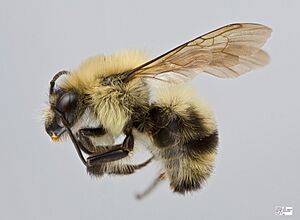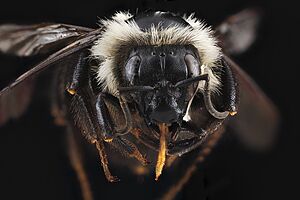Two-spotted bumble bee facts for kids
Quick facts for kids Two-spotted bumble bee |
|
|---|---|
 |
|
| Conservation status | |
| Scientific classification | |
| Genus: |
Bombus
|
| Species: |
bimaculatus
|
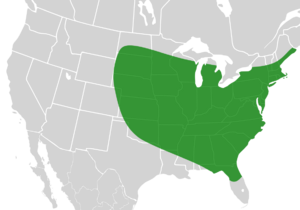 |
|
| The range of Bombus bimaculatus in the US. | |
The two-spotted bumble bee (Bombus bimaculatus) is a type of social bumble bee. You can find it in the eastern United States and the southeastern part of Canada. Its name comes from the two yellow spots on its body. Unlike many other bumble bees, the two-spotted bumble bee is doing well. Its numbers are stable, not decreasing. These bees are great pollinators and visit many different kinds of plants.
Contents
What is a Two-Spotted Bumble Bee?
The two-spotted bumble bee was first described by an American insect expert, Ezra Townsend Cresson, in 1863.
Female worker bees look a lot like queens. The main difference is their size. Queens are usually bigger. Sometimes, large workers can be mistaken for small queens. This happens especially later in the season. Queens have a black face with a yellow patch of hair on top of their head. Their main body part (thorax) is yellow. It has a shiny black area in the middle. Their underside is black with some yellow hairs on their legs.
Male bees have a mix of black and yellow hairs on their faces. They look similar to females. However, males have more yellow hairs on the sides of their second body segment (tergite). Females have black edges and fewer yellow hairs there.
Where They Live
B. bimaculatus mostly lives in eastern temperate forest areas. These are found across the United States and southeastern Canada. They can also live in coastal plains and parts of the Boreal forest and Great Plains.
These bees make their homes underground. They prefer areas near woods and gardens. Nests can be 6 to 12 inches deep. The tunnels leading to the nest can be 9 inches to 4 feet long. B. bimaculatus can also nest above ground. They might use hollow logs or other hidden spots. Bees do not build their own nests. Instead, they look for old rodent dens or other suitable places. Queens sleep through winter in loose dirt or rotting logs.
This bumble bee is very common. Its population is growing steadily. This is good news, as many other bumble bee species are declining.
The Bumble Bee Life Cycle
Bumble bee colonies last for about one year. A new colony starts when a queen, called the foundress, wakes up from hibernation in spring. She has already mated. She must find a good spot to build her nest all by herself. She brings pollen and nectar to the nest. Then she lays her eggs. The first bees to hatch will be female workers. They cannot reproduce. At this time, the queen has to take care of the young. She also has to find food. This is the hardest time for a new colony.
Eggs hatch in about four days. The young bees (larvae) eat for two weeks. Then they spin cocoons and turn into pupae. After another two weeks, they become adult bees. Once the workers appear, the queen lays more eggs. Workers usually appear in May and are most common in July. They take care of the young. They also find food, control nest temperature, and protect the nest. Male bees appear later, in June, and are most common in July. Unlike workers, males leave the nest to find mates. New queens are born around the same time as males. They eat a lot to store energy for winter. New queens return to the nest at night.
B. bimaculatus queens are some of the first bumble bees to appear in spring. They can be seen as early as February. By fall, the new queens will be hibernating. They will start the cycle again next spring. The old queen, workers, and males will die. These colonies grow and die faster than some other bumble bee species.
How They Behave
Male Incubation
Male B. bimaculatus can help care for young bees (larvae). They do this during their first days or weeks of life. Female workers usually do this job. But males cannot fly for their first 24 hours. So they stay in the nest. Helping to warm the larvae might help them practice their flight muscles. They sit on the cocoons like females do. They pump their bodies to move heat from their chest to their belly and then to the young. Male help might be more important later in the season. This is when there are fewer workers to care for the young.
Mating
B. bimaculatus bees mate outside the nest. Males fly around in circles looking for a queen. Most queens mate only once. However, some queens mate multiple times. This means their young can have different fathers.
Foraging for Food
B. bimaculatus queens look for food on Aquilegia flowers. They hang upside down on the flower parts. They grab the stem with their front legs. Then they scrape off pollen with their middle and back legs. Workers push their heads into the flower's spurs. They then use their long tongues to drink nectar. They do this on many spurs of the same plant. Then they move to the next flower.
The tongues of B. bimaculatus queens are about 10.5 to 12.2 millimeters long. This length is different from most other bumble bee species. This might be why they are such good pollinators.
Scientists compared B. bimaculatus to the carpenter bee. They found that B. bimaculatus learned faster. They also had more flexible ways of finding food. This might be because bumble bees are social. Individuals can focus on finding either nectar or pollen. Carpenter bees are not social, so they have to find both types of food themselves.
How They Look Like Other Insects
Many fly species look like bumble bees. This is called Batesian mimicry. It helps them avoid predators. Examples include robber flies, flower flies, and bee flies. Some beetles, moths, and even other bees also copy the look of bumble bees. The bumble flower beetle does not look like a bumble bee. But it makes a similar buzzing sound when it flies.
Bumble bees also look like each other. This is called Müllerian mimicry. It happens when different dangerous species share similar warning colors. B. bimaculatus looks similar to other bumble bees in its area. These include B. impatiens and B. griseocollis. They all have a mostly yellow body with a darker spot in the middle.
Their nests are usually hidden underground or in holes. So they do not need special camouflage.
Interactions with Other Species
What They Eat
Bumble bees eat nectar and pollen from plants. B. bimaculatus pollinates many different plants. But they do have favorites. Queens like willow and plum flowers. Workers prefer red clover and mint. Males are found on mint and sweet clover.
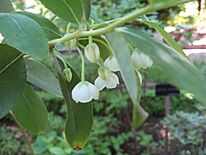
They have been seen getting food from these plants:
- Zenobia pulverulenta
- Gelsemium sempervirens
- Lyonia lucida
- Solanum dulcamara
- Aquilegia species
- Dicentra species
- Mertensia species
- Pedicularis species
- Aesculus glabra
- Camassia scilloides
- Delphinium tricorne
- Hydrophyllum appendiculatum
Predators
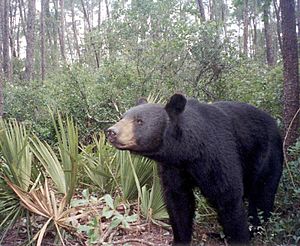
Animals that eat bumble bees include crab spiders, Florida black bears, ambush bugs, robber flies, dragonflies, and some wasps. Crab spiders hide on flowers. They attack B. bimaculatus, paralyze them, and then eat them. Florida black bears eat a lot of B. bimaculatus in spring. They eat fewer in summer.
Defense
B. bimaculatus will protect its nest from invaders. One such invader is Psithyrus variabilis, a type of cuckoo bumble bee. In one test, a female P. variabilis was put into a B. bimaculatus nest. The workers quickly knew she was an intruder. They stopped working and attacked her when she went deeper into the nest.
However, sometimes B. bimaculatus bees ignore intruders. For example, they often ignore Psithyrus labrosius. This is another cuckoo bumble bee. It attacks Bombus vagans but not B. bimaculatus, even though they are closely related.
B. bimaculatus queens can fight and kill each other. Queens can also be mean to other queens of their own species. They might squirt waste in their faces.
Parasites
Brachycoma sarcophagina is a type of parasite that eats B. bimaculatus bees from the outside. Female B. sarcophagina lay tiny larvae on B. bimaculatus larvae. These parasite larvae wait until the host bee starts spinning its cocoon. Then they begin to eat it.
Tracheal mites can infect many bumble bee species. But they really prefer B. bimaculatus. These mites were found in the air sacs of the bees. These mites can change bee behavior and make them live shorter lives. This can cause problems for colonies.
Conopid flies also parasitize B. bimaculatus. Male bees were less likely to be infected than workers. Larger bees were more likely to be infected than smaller bees.
B. bimaculatus is also infected by Bombus citrinus. This is a cuckoo bumble bee that lays its eggs in the nests of other bumble bees.
Diseases
B. bimaculatus can get sick from Nosema bombi, a tiny organism. They can also get other fungal infections. It is not fully known how bad these infections are for the bee's health. Compared to other bumble bees that are declining, B. bimaculatus has lighter infections. This might be why its population is stable.
B. bimaculatus can also be infected by Crithidia bombi and Apicystis bombi. Both are tiny organisms. C. bombi is known to make it harder for colonies to start. It also shortens the bees' lives and harms the colony's health. This can cause a lot of stress for colonies and lead to a species' decline.
Why They Are Important to Humans
Pollinators
B. bimaculatus is a very important pollinator in forest areas. This is because it is still common. Many other honey and bumble bee species are not. They also pollinate many different plants. Bumble bees can keep finding food even when the weather is not perfect. They can fly even when it is raining or cloudy. B. bimaculatus can even fly when it's as cold as 7°C (45°F). So, the continued health of B. bimaculatus is very valuable.
Sting
Only female bees can sting. Male bees do not have a stinger. Bumble bees usually only sting if they are protecting their nest or if they are caught. Allergic reactions to bumble bee stings are less common than to honey bee stings. Even though their venom is similar. B. bimaculatus venom has extra proteins. These include some related to blood clotting.



